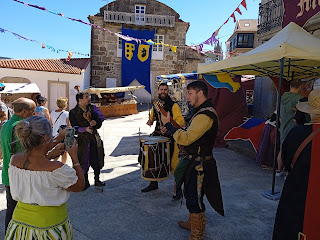May was an optimal time to go to the second largest Balearic island. The seasonal restaurants had mostly been open since Semana Santa. The weather was delightfully warm during the day, but cool at night. Nothing too aggressive. And there was practically no one around! Ok, so it's not like it was a no-man's land, but there were minimal to no crowds. I've got a lot to go over, so I'll be dividing and conquering. Let's start with Menorca's lovely cities and villages.
MAÓ/MAHÓN
Menorca's capital and our home base. I want to call it a city, but seeing as it has a population of less than 30,000 that might be an exaggeration. As we were driven in from the airport, we winded along the endless port area, with back-to-back restaurants of all sorts, their terrazas steps away from the water. Maó's port is one of the biggest natural ports in the Mediterranean. The city itself is higher up, with definite Mediterranean vibes. Just the color palette of warm shades was an obvious difference from Galicia.

But my favorite place in Maó was technically not even in the city limits, but rather in the next town over, in their smaller harbor. Cales fonts! I swear I felt like I was either in a movie or a TV program about Europe. A European boardwalk. I think the quiet stroll over makes the sight all the more breathtaking. On the way over, we walked through a residential area that seemed mostly abandoned before summer. We crossed paths with perhaps two people. Then suddenly when you get to the dock you can spot lively Cales Fonts glowing in the distance. The wooden walkway over to it hugs the cliffs on the left, with boats rocking on your right. Cales Fonts is a harbor full of restaurants and their
terrazas, with warm lighting reflecting off the water. Also, because it was May, finding a table wasn't a source of stress. In fact, we ended up having dinner here twice. I was enamored!
.jpg) |
| Dinner with a view. Quintessential Mediterranean |
CIUTADELLA
On the western tip of the island is Menorca's other major city: Ciutadella. Again, the feeling of we're not in Galicia anymore! Tan, yellow, and beige buildings everywhere. We really only were there for lunch and a quick walk around town before and afterwards. It was a sunny Sunday so there were plenty of people, perhaps locals, milling around.
 |
| Warm: Menorca's weather and color scheme |
BINIBÈQUER/BINIBECA
I don't care if this isn't an actually populated village, and is more of a tourist destination than anything else. I was absolutely enraptured! When we parked, my friend said ¨You're going to love this!¨ First we walked past an average
terraza with a handful of people drinking in the shade. Nice, I guess. Then he ducked down some stairs which I thought led into the kitchen of the bar. ´Where the heck is he taking us?!´ I thought to myself. And then: all was revealed! We were surrounded by a labyrinth of white houses. Completely white. Just some dark mahogany beams to contrast every once in a while. It was glorious! Once again, coming in May we really nailed it. It might have even been just as nice in off-season. But to have to share those alleyways with a horde of others in summer months would have made it lose it's charm. There were a few other people walking among the white, past signs begging for ¨Silence, please.¨ At the end of our trip, when we were talking about our favorite parts/places in Menorca, my friend was right. Binibeca was certainly mine!
ES MIGJORN

As far as tourism goes, this sleepy town hasn't got much to offer. It's not right next to the coast, which is what the vast majority of people come to Menorca for. It isn't filled with bars and their cute patios (We stopped at what appeared to be the village's only bar). However, it is a real town (unlike Binibeca), with its own cute white houses. Also, I'm not sure if it was because the day we visited just happened to be the village flower festival, or if the place is always so adorable, but just about every single house had flowers outside in the (pedestrians only) street. And most of the flower pots were made from upcycled bottles and other items. Super! On the ¨main street¨ they also had colorful flags with (unknown to us) words strung along them. We were puzzled. Finally someone was able to explain that the town hall had collected specifically Menorcan words that were slowly disappearing. It was a way to remind passersby of them and be proud. The linguistics fans of the bunch were delighted.





.jpg)






.jpg)

.jpg)

